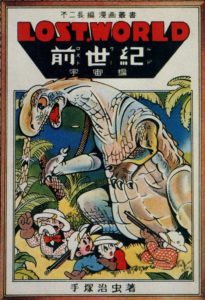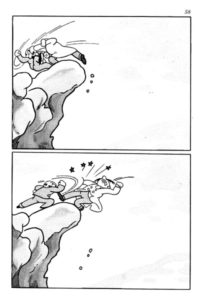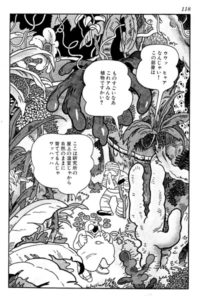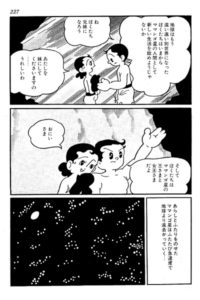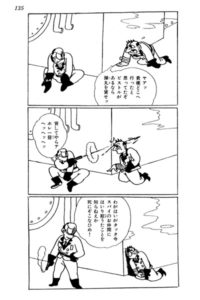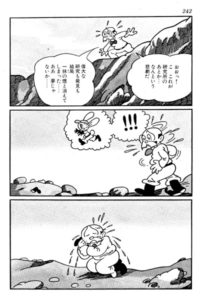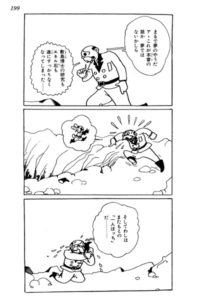Lost World (Manga)
Also known as ロスト・ワールド (Rosuto Wārudo)
| English Title: | Lost World |
| In English? | Yes |
| Japanese Title: | ロスト・ワールド Rosuto Wārudo |
| Type: | Book |
| Original run: | 1948/12/20 |
| Published by: | Fuji Shobo |
| Volumes: | 1 MT-130 |
Lost World (1948), the opening act in Osamu Tezuka’s early “science-fiction trilogy”, was originally published by Fuji Shobo as as a book-length adventure split into two parts. Both Volume 1 (subtitled “The Earth”) and Volume 2 (subtitled “The Universe”) both hit the shelves at the same time on December 20, 1948.
What it’s about
Volume 1: The Earth
Late one night, Mimio – a real-life walking, talking rabbit – is woken from his bed by the sound of gunshots. The sound also catches the attention of the famous detective, Shunsaku Ban, and as the pair investigate, they discover a man has been murdered and his glass eye is missing. Mimio explains that Dr. Kenichi Shikishima, the boy genius scientist that created him, was the previous owner of the eye and suggests they pay him a visit. After a warm welcome, Dr. Shikishima explains that the eye was made from one of seven stones that fallen to earth from the mysterious planet known as Mamango. Formed from a chunk of the primordial Earth, it is approaching our planet for the first time in 5 million years.
However, Dr. Shikishima‘s experiments on the small fragments of Mamango rock have reveal an amazing property. When exposed to a small electrical current, the stones emit a huge amount of energy. Worried that such power has the potential to become a weapon Dr. Shikishima has hidden the stones might fall into the wrong hands.
Of course, news of the “energy stones” has reached the mysterious “Mamango Secret Society” – a gang of crooks that includes Afill, Kao Sekken and Gratin, and that will stop at nothing, including murder, to gain their power. After one of their members, disguised as Shunsaku Ban, tricks Dr. Shikishima into handing over the stones, the real Shunsaku Ban gives chase and the two of them end up plunging off a cliff and into a raging river. Although they both survive, when Shunsaku discovers the entrance to the Mamango Secret Society’s hidden base, it sets of a madcap series of events and hairpin reversals of fortune. Luckily, with a bit of subterfuge of their own, Shunsaku and Mimio are eventually able to bring their would-be captors to justice.
Volume 2: The Universe
With the danger posed by the secret society behind them, Dr. Shikishima, Shunsaku Ban and Mimio turn their attention to mounting an expedition to the quickly approaching planet Mamango. Drawing on the power of the energy stones, a rocket ship is quickly constructed, and in no time, Dr. Shikishima, Shunsaku Ban, Mimio, Dr. Makeru Butamo, his humanoid plant creatures Miss Ayame and Miss Momiji, and the rest of the crew all blast off into space. The success is short-lived however, as it’s soon discovered that a crooked newspaper reporter named Acetylene Lamp has stowed aboard when his added weight begins to cripples the finely balanced ship, setting it adrift in space.
With food and water becoming a scarce resource aboard the listless ship, the crew becomes increasingly desperate – to the point were Lamp, shockingly, eats Miss Momiji, one of the vegetable girls! Although he’s cornered by Shunsaku Ban, before the ethical debate can begin, Dr. Shikishima suddenly announces that the approaching Mamango has caught the disabled rocket in its grasp and that they are about to make planetfall!
Down on the surface, the group finds a land straight out of the distant past, where giant ferns and dinosaurs still roam – a lost world indeed. After a short pause to restocking their provisions, the group begins to explore and quickly finds a major source of the amazing energy stones. Of course, that’s when all hell breaks loose. First, it’s revealed that Dr. Butamo‘s intentions in creating the humanoid plant girls had less to do with pure scientific research, and more to do with impure “marriage” plans. Then it’s discovered that crooks of the Mamango Secret Society were also stowaways aboard the rocket and had been biding their time until the energy stones were located.
Of course the rampaging crooks are no match for the rampaging dinosaurs, and to make matters worse the proximity of Earth begins to cause massive electrical storms and tectonic shifts on Mamango. Trapped by the storms, Kenichi Shikishima and Ayame are left behind and they can only watch helplessly as the rocket lifts off and heads towards home. All alone, Kenichi decries they will “become brother and sister” and live as the King and Queen of Mamango. Meanwhile, aboard the rocket, Lamp ambushes Shunsaku Ban and Mimio and, after a massive fistfight breaks out, he is forced out the airlock. Ban has no time to celebrate as he quickly evacuates the crippled ship. However, Mimio is trapped and Ban watches in horror as the doomed craft crashes to earth. In the end, Shunsaku Ban, as the sole survivor, can only tearfully look at one of Mimio‘s empty little boots and reflect on how it all went so wrong…
What you should know
Lost World (1948) is quite obviously one of Osamu Tezuka’s earliest works. Although it is a great example of Tezuka’s early enthusiasm as an artist, the rough artwork and frantic sci-fi action storyline can make it confusing and hard to follow – especially for modern readers who are just beginning to discover and explore Tezuka’s works.
Although the “standard” version of Lost World (1948) – which was first printed in 1948 by Fuji Shobo – is considered the opening act of a “science-fiction trilogy” that also includes Metropolis (1951) and Nextworld (1952), Lost World (1948) is actually one of Tezuka’s most primordial manga creations. A more prototypical version of the story, now known as Lost World [Private Edition], stretches all the way back to Tezuka’s middle school days in the early 1940s.
Even rougher than the standard version, Lost World [Private Edition] has all the hallmarks you might expect from a young amateur’s work; the storyline is rambling, the artwork contains only the sparsest of background details, and, unconstrained by the need to pander to a target demographic, the violence and bloodshed is much more graphically (if not quite realistically) portrayed. Even the title, which was pinched from Arthur Conan Doyle‘s novel for no other reason than it “sounded good”, was innocently misspelled (in English) as “Rost World” to boot!
However, one of the most interesting differences between the two editions is the relative age of the main protagonist, Kenichi Shikishima. In Lost World [Private Edition], Kenichi is a young man not a boy genius. This means that the romantic aspects of the relationship with the plant girl Ayame are much more natural – without the stilted narrative of them suddenly deciding to “become like brother and sister” that was later necessary to appease the sensibilities of the young readers.
Of course, appeasing those sensibilities didn’t necessarily mean pandering to them. Tezuka rarely spoke down to his readers and he sheltered them even less. The harsh realities of a cold, uncarring world, often find their way into his works and, as such, his tales rarely have simple, happy endings. In fact he often went out of his way to make his early works such as The Mysterious Underground Men (1948) and Lost World (1948) as realistic and impactful as possible. As Tezuka himself mentions in the afterword to the Osamu Tezuka Complete Manga Works edition (MT-130), “I believe this was a forerunner of gekiga” (p. 250, 1982).
Despite its flaws, Lost World (1948) is also a treasure trove of Tezuka’s themes and ideas piled one on top of the other – many of which (such as rogue planets and sentient plant life, for example) are more smoothly deployed and more deeply explored in his later works. As such, it is an important piece of the puzzle when considering Tezuka’s manga catalogue as a whole.
Where you can get it
Luckily, for English-speaking fans, Lost World (1948) was published by Dark Horse in 2003 as part of Tezuka’s science-fiction trilogy titles, alongside Metropolis (1949) and Next World (1951).

